
Photo. The Stonehenge. Is the builders sun worshipers? It`s probably not so surprising since the sun give life.....
Stonehenge is a circle by huge stones located in the middle of the barren expanse of Salisbury Plain, 1,5 hour drive from London. It is considered as the most important monument in the whole Britain. Its remains stand timeless in the middle of an English meadow.
Nowhere else in the world are there similar monuments, which are shaped so well as Stonehenge (Salisbury). The first stone was set up here for 5000 yeas ago and the last stone was placed 1400 years later. Take a more carefully look at the stones and the surroundings, and you will see that the mystery is even bigger than the stones themselves.
The incredible design and construction of Stonehenge shows a number of features, which can compares with other places. Despite for differences in design, the purpose for their function is probable the same. Many people (especially the British) say that Stonehenge is unique in the world. One recently exploration may changes this consideration. There have actually been found similar constructions elsewhere.
In August 2000 archaeologists found remains of two prehistoric stone circles in Germany, which are approximately 2000 years older than the English Stonehenge. Sun worshipers probably built these stone circles. Actual there are over 50 stone monuments in Europe. In addition there are several others elsewhere. Stonehenge might be unique because the stones looks like they are set up in a circle, but this is also a matter that could be discussed. But anyway it's a masterpiece of engineering construction work.
Cross-references to other prehistoric monuments?
I think personally that these prehistoric people erected this monument to please their god, and their god was the sun. In my opinion Stonehenge must be inspires from heaven. So early at this time people seem to have astronomical knowledge and inspirations.
According to English Heritage organisation, there has early in the eighteenth century been recognised that the axis of the sarsen stone circle points roughly to where an observer at the centre of Stonehenge would see the longest day of the year, in its most northerly position on the horizon. The entrance was also reoriented slightly during the lifetime of Stonehenge to compensate for astronomical variation in the midsummer sunrise over many centuries.
| Photo. Stonehenge - an eternal unsolved mystery? © Travel Explorations. |
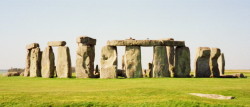 |
Have the people in Neolithic and Bronze Age real scientific knowledge about astronomy, or it is more symbolic linked with the directions of the risings and settings of the sun?
It is hard to believe that the driver for building this monument have been scientific research. Anyway it has been suggested that the lines joining the four Station Stones could also have marked the most northerly and southerly positions on the horizon of the risings and setting of the sun and the moon. The latitude of Stonehenge was chosen so that the pairs of the directions would be at right angles.
Further more it has also been suggested that the ring of Aubrey Holdes have been used as a simplified model of the motions of the sun and the moon, so as the eclipses, and it has been claimed that the Stonehenge served as an observatory for very precise observations of the extreme risings and settings of the moon.
For me it is natural to draw parallels to other prehistoric monuments in the world as the pyramids. I believe that Stonehenge had a similar function as the pyramids in Egypt, Mexico and Guatemala, and also temples in the jungle for example in Cambodia (Angkor Watt and other temples in this country). And even stronger links: there are kind of stone circles in Bolivia and Peru too. They stone are incredible big, and there are so far no reasonable answers to how the constructions were done.
|
Photo. Monoliths at the ancient city Tiahuanaco in Bolivia.
© Travel Explorations.
There are also distinctive stone heads on the walls, mysterious stone carvings, stone maps, calendars, high statues, open air and semi-underground temples in this site.
|
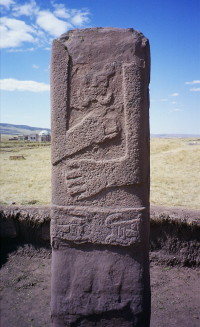 |
|
Photo. One of many big stone wonders in Peru (from the ancient holy Inca city).
© Travel Explorations.
As the famous Norwegian adventurer and scientific Thor Heyerdahl, would have asked: is there a connection?
|
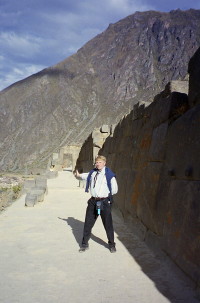 |
As far I can see they are all monuments built to fill a certain mission. The mission for these monuments stands clear for me: the way they are formed seems to have an obvious connection with "gods in heaven". And the biggest god of them all is the sun. It is not so unreasonable to believe this because the sun gives life on earth. Without the sun we would have not existed. At that time it was the only way to build a "stairway" or link between earth and heaven.
Now we have spaceships and satellites exploring the universe and reach the moon and the sun. I am holy convinced that all these monuments have something in common: ancient people many places around in the world may have mapped the course of the sun and moon to build these outstanding monuments.
Photo. The Great Pyramid in Egypt. Is there a symbolic connection with Stonehenge? Maybe it's a scientific connection too?
© Britt & Steinar Nyhus. |
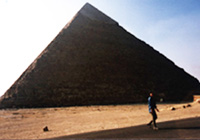 |
I also believe that the strange lines in Nazca in Peru, is inspired by the power of the sun. Here you find huge geometric designs, mostly of animals and birds (believed to be built between 900 BC and 600 BC). These people were probably sun worshipers.
I suggest it is a same thought behind it in Traelleborg in Denmark too. Here you can find several strange stone circles in the country's green flat meadows. This is also a great mystery, maybe bigger than the Stonehenge.
In Uppsala in Sweden there are small stones lined up (it is said that it is shaped as a ship. It was recognised as an Viking burial site). In Bretagne in France there monoliths spread over a wide area. It's not formed as a circle, but it's definitely a plan behind the formation of set up. Could it be a digit code, or another kind of message from the past? Maybe we can solve these parallel mysteries by putting the pieces together in the big puzzle?
Purpose of the Stonehenge
What has Stonehenge been used to? As mentioned earlier it may have been an open door temple and observatory, but as other monuments in the world, the Stonehenge could have filled many functions during thousand of years:
1. Observatory (constructed based on astronomic knowledge; symbolic or scientific?) Where these people sun worshipers (related to the summer solstice)?
2. Calendar
3. Ceremonial place (for many rituals)
4. Ritual sacrificial place
5. Graveyard for leaders
6. Meeting place for traders
For a year ago, it was a new exploration in Stonehenge. A skeleton of a man was found in a shallow grave. This raised the question: do we have to reconsider our understanding that this old monument has been a holy place only, and has only been used to measure summer and winter solstice, and then at a later time been used to execute people? This exploration amazed the archaeologists because it shows that the man was executed. The man's head seems to be chopped off by a metal sword.
The angel for chopping shows that the man was attacked from behind. The mark of the chop shows this clearly. This indicates that there was an execution. So far they know the victim was 1,65 metres high and he was in the thirties. The man had prominent teeth.
Use of metal swords dates the execution in time between 100 years before Christ and 1000 year after Christ. The exploration really surprised the archaeologists because they thought that Stonehenge was not used after 1500 years before Christ. They hope that a C14-dating soon will give them a more accurate time reference. The time will show…..
| Photo. Stonehenge - a link between earth and heaven in the past? Anyways it is a real wonder of the world! © Travel Explorations. |
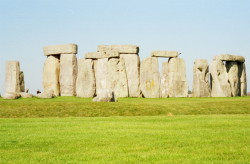 |
The unique design and constructions of Stonehenge shows a number of features, which can be found other places. Anyway the purpose for their function is probable the same. The finale stage of Stonehenge has bee dated to about 1600 BC. The last part of the story has been collared by destruction. Many of the sarsen stones have disappeared.
Today the mystery still goes on. No one actual know why, how and who built the Stonehenge. So I wonder; will I live long enough to get the answers? Would the secrets ever be revealed?
Stein Morten Lund, 7 April 2002
Additional information
English Heritage:
English Heritage looks after over 350 historic buildings and monuments in England, most of with are open to the public. All these and more are open to free to members of English Heritage. Full details are given in the English Heritage Guide (on sale at the monuments, or free to members). You can help English Heritage to improve public enjoyment and understanding of its property by becoming a member. In addition to free admission to all sites you will receive a regular Magazine informing you about properties and special events. Details are available at any manned monuments or, by post only, from English Heritage, PO Box 1BB, London W1A 1BB.
Website: English Heritage
Local Museums nearby Stonehenge:
Visitors are advised to check hours of admission in advance before making a long journey.
Salisbury and South Wiltshire Museum:
The King's House, 65 The Close, Salisbury
SP1 2EN. Telephone: 01722 332151
Open: Monday-Saturday (and Sunday afternoons in July and August).
Items from the excavations in the Stonehenge Gallery and a special exhibit on Early Man in Wiltshire.
Devizes Museum:
The Wiltshire Archaeological and Natural History Society.
41 Long Street, Devizes SN10 1NS
Telephone: 01380 727369
Open: Tuesday-Saturday
Artefacts from the barrows and other prehistoric collections. Henge Monument Room.
Alexander Keiller Museum Avebury:
Avebury, Marlborough SN8 1RF
Telephone: 01672 539250
Open: Monday-Sunday
Flints and pottery from excavations at Avebury, Windmill Hill, Silbury Hill and West Kennet.
Facts about Stonehenge:
Stonehenge was constructed in three main phases:
3050 BC - (5050 years ago): Circular ditch and bank (a henge).
2500 BC circa - (4500 years ago): Wooden structure constructed at centre.
2500 - 1500 BC - (4500 - 3500 years ago): Stone monument constructed, arranged and rearranged over almost 1000 years.
For more information about the chronology, see book Monuments in its Landscape by Cleal, Monague and Walker (English Heritage; 1985).
The Sarsen Circle: about 30 metres in diameter. It consisted originally of 30 uprights, each weighting about 25 tonnes, capped by a continuous ring of 30 lintels weighing about 7 tonnes. Inside it was a horseshoe of five Sarsen Trilithons each consisting of a pair of huge uprights, weighing up to 45 tonnes, capped by massive lintel.
Facts about Avebury stone circle:
This stone circle is located in Avebury and consists of nearly 700 megaliths weighing up to 40 tons, which were dragged here centuries ago. Thoroughly explorations have been done through the last century. Some people say that they could not have been placed there by man alone. What do you think?


















